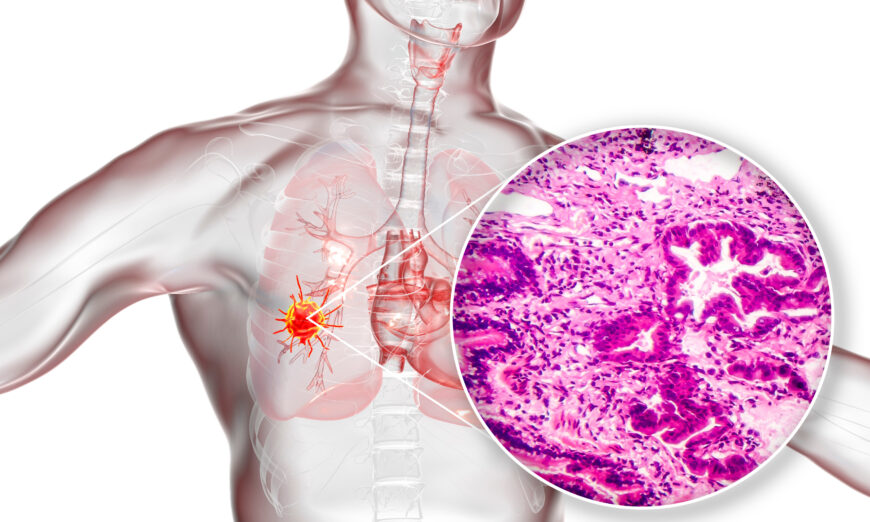The identification of genomic alterations within driver oncogenes has revolutionized the management of non–small cell lung cancer (NSCLC). Indeed, we now approach the twentieth anniversary of the discovery of epidermal growth factor receptor (EGFR) mutations in NSCLC, a finding that catalyzed a new paradigm of precision medicine that has culminated in regulatory approvals of more than 20 targeted agents across various oncogenes. Importantly, insights into EGFR-mutant biology have continued to provide a roadmap for management of oncogene-driven NSCLC. Historically, EGFR-mutant NSCLC has been classified into 3 distinct subgroups. Classic EGFR mutations, which are characterized by exon 19 deletions or the exon 21 L858R substitution, account for approximately 80% of EGFR mutations and confer marked sensitivity to EGFR tyrosine kinase inhibitors.1 By contrast, EGFR exon 20 insertion mutations, which compose approximately 10% of EGFR mutations, are generally insensitive to treatment with early-generation EGFR inhibitors. Finally, uncommon or atypical EGFR mutations comprise a heterogeneous group of point mutations, deletions, or insertions within exons 18 to 25 and make up the remaining 10% to 15% of EGFR mutations.2 Currently, the optimal management of patients with these atypical mutations remains an open question. Okuma and colleagues3 present findings from the UNICORN study, a prospective, multicenter, phase 2 trial aimed at evaluating the clinical activity of the third-generation EGFR inhibitor osimertinib in patients with NSCLC harboring uncommon EGFR mutations. Among 42 treatment-naive patients enrolled over a 2-year period, the objective response rate (ORR) was 55% with a median progression-free survival (PFS) of 9.4 months. The median duration of response was 22.7 months. Consistent with earlier studies using osimertinib, common adverse events included diarrhea (47.5%), acneiform eruption/rash (42.5%), thrombocytopenia (65%), and mucositis (32.5%), but only 3 patients (7.5%) required dose reductions.
The UNICORN study3 raises several important questions. First, what is the role of osimertinib in NSCLCs with uncommon EGFR mutations moving forward? Currently, the only approved therapy for this subgroup of patients is the second-generation EGFR inhibitor afatinib. The US Food and Drug Administration and European Medicines Agency approval of afatinib was based on a post hoc analysis of patients enrolled in the LUX-Lung 2, 3, and 6 trials.2 Among 75 patients with NSCLCs harboring atypical EGFR mutations in these trials, afatinib demonstrated an ORR of 71.1% and median PFS of 11 months. Despite this activity, afatinib has been associated with high rates of skin and gastrointestinal toxicity, along with frequent need for dose reductions (28%-53%) owing to inhibition of wild-type EGFR.4 Given these concerns, there has been ongoing interest in exploring osimertinib among patients with uncommon EGFR mutations. As a third-generation EGFR inhibitor, osimertinib demonstrates relative sparing of wild-type EGFR, activity against EGFR gatekeeper resistance mutations (ie, T790M), and high central nervous system penetrance.1 Of note, uncommon EGFR mutations were generally excluded from early clinical trials of osimertinib, but several noteworthy studies have since emerged. For example, in one international, retrospective case series of 60 patients with uncommon EGFR mutations, osimertinib was associated with an ORR of 61% and median PFS of 9.5 months.5 In a separate prospective phase II study, KCSG-LU15-09, which enrolled 37 patients with atypical EGFR mutations treated with osimertinib in Korea, the ORR and median PFS were 50% and 8.2 months, respectively.6 Together with the UNICORN trial,3 these studies demonstrate consistent results and support consideration of osimertinib as an additional agent within the treatment armamentarium for patients with uncommon EGFR mutations.
A critical question moving forward is whether all uncommon EGFR mutations should be treated using the same approach. The short answer appears to be no. Among the most common atypical EGFR mutations, clinical outcomes have been heterogeneous. For example, across the KCSG-LU15-09 and UNICORN studies, patients with EGFR L861Q mutations consistently had superior clinical outcomes (ORRs, 75%-80%) while taking osimertinib, while patients with EGFR G719X and S768I mutations had more modest ORRs (45%-53% and 38%-50%, respectively).2,3,6 Such differences have prompted investigators to question historical, exon-based classifications of EGFR mutations and instead define structure-based relationships with drug sensitivity.7 Within this new paradigm, EGFR L861Q mutation is defined as classiclike alongside EGFR L858R and exon 19 deletions due to its apparent sensitivity to third-generation EGFR inhibitors like osimertinib. In contrast, both G719X and S768I map to the interior surface of the ATP-binding pocket or the C-terminal end of the αC-helix (PACC) and are termed PACC mutations.7 Because the PACC mutations alter the orientation of the P-loop and the αC-helix, affinity of EGFR binding to osimertinib may be decreased. Interestingly, afatinib does not interact with the P-loop but rather with the hydrophobic core, suggesting that this agent may have improved clinical activity against PACC mutations.7 Indeed, in Lux-Lung 2, 3, and 6, the ORRs among patients with EGFR G719X and S768I mutations treated with afatinib were 77.8% and 100%, respectively.2 Furthermore, a recent retrospective analysis demonstrated significantly longer time to treatment failure among patients with PACC mutations treated with second-generation EGFR inhibitors compared with third-generation agents.7 Collectively, these findings emphasize that atypical EGFR mutations represent a diverse and heterogenous group, and treatment of these patients using small molecules must be individualized, accounting for the molecular nature of each mutation and its functional impact on the protein and drug interaction to guide therapy.
More broadly, the UNICORN study3 highlights that for rare mutations where randomized clinical studies are not readily available, well-conducted, prospective single-arm studies may provide important insights. In addition, real-world series/registries and basket trials, such as the MATCH trial (NCT02465060), may be important vehicles to examine the activity of targeted therapies on increasingly rare molecular subgroups. Next-generation sequencing should be broadly applied to improve identification of these mutations (and other oncogenic drivers), since some EGFR alterations (eg, E709X, exon 20, and kinase domain duplications) may be missed using polymerase chain reaction alone.
Despite continued advances in the management of advanced, EGFR-mutant NSCLC, patients continue to relapse while undergoing targeted therapies. Recent strategies to augment the activity of tyrosine kinase inhibitors with novel combinations have offered glimmers of hope for improving on our existing standards. Such strategies have included combinations with chemotherapy (eg, FLAURA2 [NCT04035486]), bispecific antibodies (eg, CHRYSALIS-2 [NCT04077463]), and antibody drug conjugates (eg, EGRET [NCT05647122]). While most of these approaches are initially being explored in patients with classic EGFR mutations, such antibody-based therapeutics have the potential to inhibit a broad array of EGFR mutations, both classic and atypical, due to their ability to promote receptor internalization and target downregulation in a mutation agnostic manner.
In summary, the UNICORN study3 represents an important step forward in the management of patients with NSCLC with atypical EGFR mutations. We applaud the authors for examining this important molecular subgroup, one that has been largely overlooked in clinical trials to date. Consistent with prior reports, the UNICORN study3 demonstrates that osimertinib has promising clinical activity among patients with uncommon EGFR mutations; yet, these data also underscore that one size does not fit all. Indeed, there are subgroups within this subgroup where structure-based classifications may help to better define drug sensitivities. As we look forward toward the next decade of EGFR-mutant NSCLC research, such classifications may allow us to identify those most likely to benefit from targeted therapy, while informing which patients may require treatment intensification with emerging combinations to improve outcomes.

